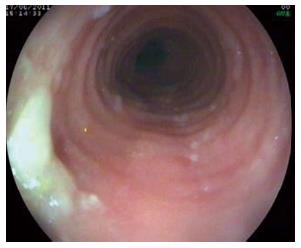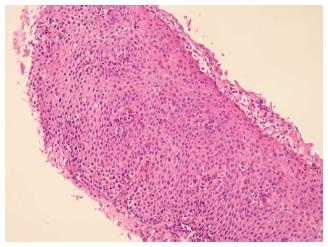Published online Feb 16, 2013. doi: 10.4253/wjge.v5.i2.79
Revised: December 15, 2012
Accepted: December 22, 2012
Published online: February 16, 2013
Eosinophilic esophagitis is an inflammatory condition of esophagus. It is generally seen in childhood and young population. Men are more commonly affected than women. However, it is not common in an advanced age. Eosinophilic esophagitis decreases the ability of the esophagus to stretch and accommodation against foods. Therefore, the major symptom in adults with eosinophilic esophagitis is difficulty in swallowing solid food (dysphagia). Specifically, the food gets stuck in the esophagus after it is swallowed. Less common symptoms include heartburn and chest pain. Because of this, it may be incorrectly diagnosed as a gastroesophageal reflux disease. Here, we reported a case presented with food impaction at advanced age. As a conclusion, eosinophilic esophagitis is a rare entity that must be remembered in advance aged patients presenting with food impaction.
- Citation: Akyüz U, Akyüz F, Özdil K, Altun H, Ağan AF, Ağan A. Food impaction in older age: Think about an eosinophilic esophagitis. World J Gastrointest Endosc 2013; 5(2): 79-80
- URL: https://www.wjgnet.com/1948-5190/full/v5/i2/79.htm
- DOI: https://dx.doi.org/10.4253/wjge.v5.i2.79
Eosinophilic esophagitis is generally seen in childhood and less often in advanced ages. It may be incorrectly diagnosed as gastroesophageal reflux disease. Dysphagia is the most common symptom. In a new report from Western society, eosinophilic esophagitis was reported in 9% of cases presented with food impaction[1-4]. Eosinophilic esophagitis presented in young adults was rarely reported in our country[5]. In this report, we reported a case presented with food impaction at advanced age.
A 52-year-old male patient was admitted to the emergency service with complaining of dysphagia and retrosternal pain started after eating. Endoscopy showed impacted food approximately 5-6 cm in diameter in proximal esophagus and was extracted with snare. Because of attended rings in esophagus (Figure 1), histologic samples were taken from mucosa of esophagus for pathologic examination. Eosinophilic infiltration (> 20 eosinophils per high power field) (Figure 2) was revealed in samples taken from esophagus and fluticasone 125 mcg inhaler therapy (3 × 4 puff) was recommended for 6 wk.
Eosinophilic esophagitis is rare entity that must be remembered in advance aged patients presenting with food impaction.
P- Reviewers Lucendo AJ, Rodrigo L S- Editor Song XX L- Editor A E- Editor Zhang DN
| 1. | Sperry SL, Crockett SD, Miller CB, Shaheen NJ, Dellon ES. Esophageal foreign-body impactions: epidemiology, time trends, and the impact of the increasing prevalence of eosinophilic esophagitis. Gastrointest Endosc. 2011;74:985-991. [RCA] [PubMed] [DOI] [Full Text] [Cited by in Crossref: 152] [Cited by in RCA: 165] [Article Influence: 11.8] [Reference Citation Analysis (0)] |
| 2. | Sperry SL, Woosley JT, Shaheen NJ, Dellon ES. Influence of race and gender on the presentation of eosinophilic esophagitis. Am J Gastroenterol. 2012;107:215-221. [RCA] [PubMed] [DOI] [Full Text] [Cited by in Crossref: 76] [Cited by in RCA: 103] [Article Influence: 7.9] [Reference Citation Analysis (0)] |
| 3. | Diniz LO, Towbin AJ. Causes of esophageal food bolus impaction in the pediatric population. Dig Dis Sci. 2012;57:690-693. [RCA] [PubMed] [DOI] [Full Text] [Cited by in Crossref: 34] [Cited by in RCA: 28] [Article Influence: 2.2] [Reference Citation Analysis (0)] |
| 4. | Ferreira CT, Goldani HA. Contribution of endoscopy in the management of eosinophilic esophagitis. World J Gastrointest Endosc. 2012;4:347-355. [PubMed] |
| 5. | Onbasi K, Sin AZ, Doganavsargil B, Onder GF, Bor S, Sebik F. Eosinophil infiltration of the oesophageal mucosa in patients with pollen allergy during the season. Clin Exp Allergy. 2005;35:1423-1431. [RCA] [PubMed] [DOI] [Full Text] [Cited by in Crossref: 85] [Cited by in RCA: 82] [Article Influence: 4.3] [Reference Citation Analysis (0)] |














